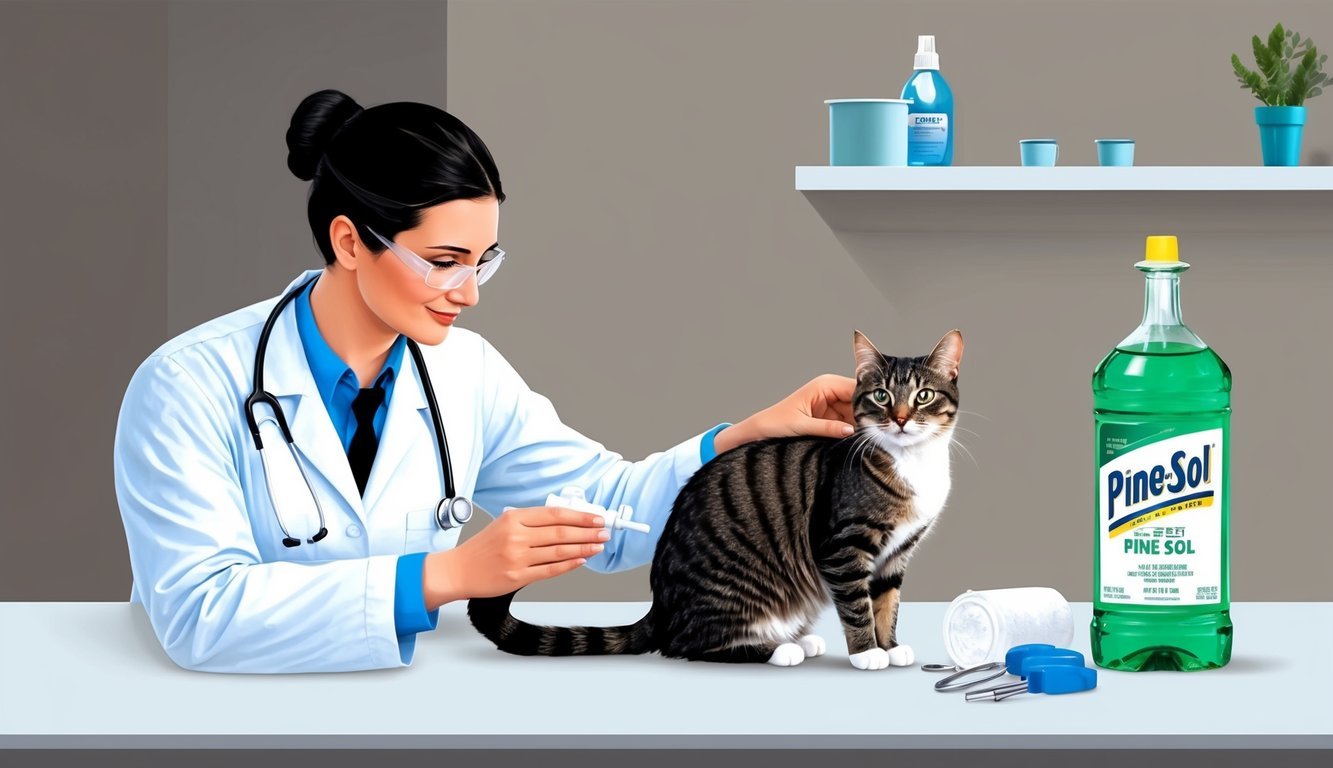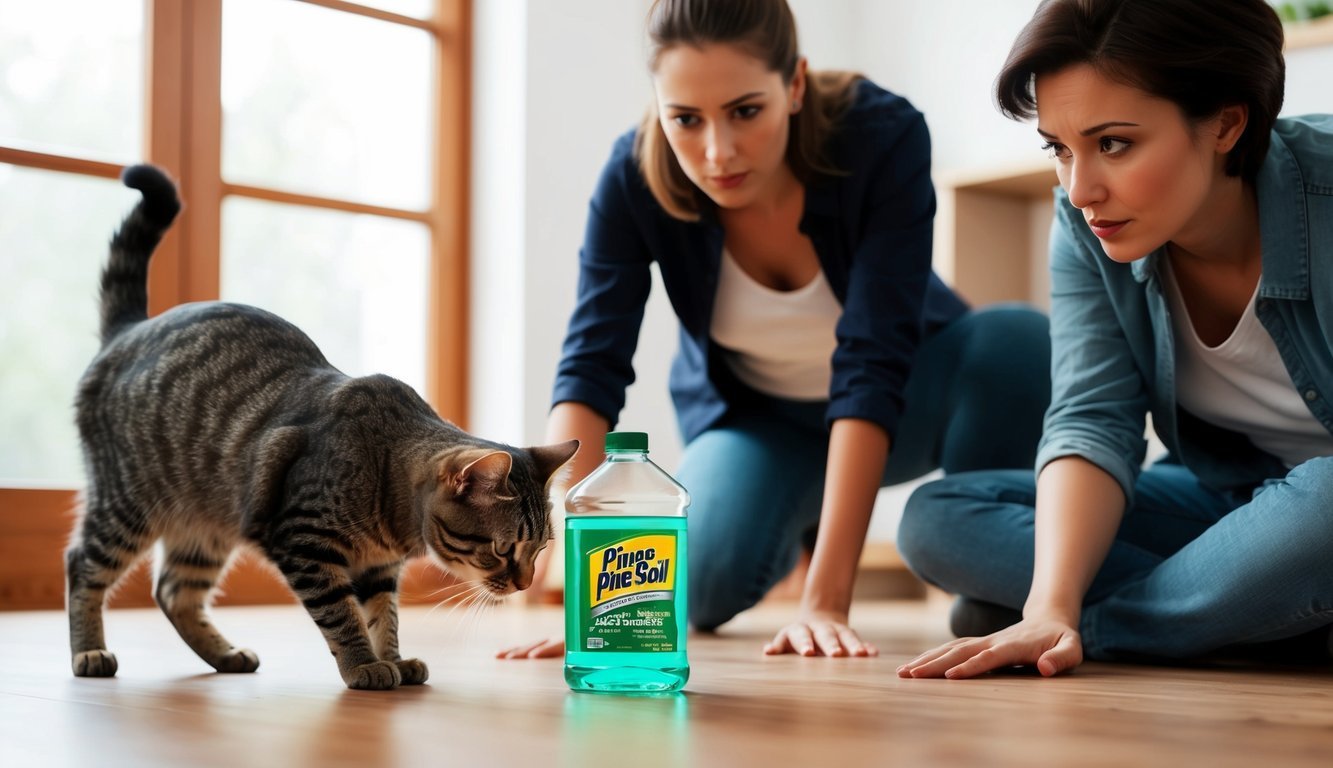Pine-Sol is a popular choice for many pet owners when it comes to keeping your home clean.
However, its harmful chemicals can pose significant risks to your feline friends.
Understanding how to safely use Pine-Sol and recognizing the symptoms of potential poisoning is essential for any cat owner.
Some sources indicate that Pine-Sol can be used around pets with caution.
However, it’s crucial to know the safe practices and alternatives available.
Your cat’s safety should always come first, and knowing what products to avoid can prevent serious health issues.
This blog will shed light on the potential hazards of Pine-Sol for cats and offer practical tips for maintaining a clean yet safe environment for your furry companion.
By the end of this article, you’ll be well-informed about the risks and safe practices related to using Pine-Sol in your home.
You’ll also discover effective cleaning alternatives that keep your space spotless while ensuring your cat’s well-being.
Key Takeaways
- Pine-Sol can be hazardous to cats due to its toxic ingredients.
- Recognizing symptoms of poisoning is vital for prompt veterinary care.
- Explore safer cleaning options to protect your feline friend.
What Is Pine-Sol?
Pine-Sol is a popular household cleaner and disinfectant made by the Clorox Company.
It’s designed as a multi-surface cleaner, which means you can use it on various surfaces around your home, like floors, counters, and appliances.
The key selling point of Pine-Sol is its ability to effectively clean while also sanitizing.
It targets dirt and grime, leaving surfaces fresh and odor-free.
Many people appreciate its strong, distinctive scent.
Originally, the formula contained pine oil, an ingredient that proved to be harmful to cats.
Due to this concern, Pine-Sol has since altered its formula, focusing on safety while still delivering effective cleaning performance.
You can use Pine-Sol diluted in water for regular cleaning or undiluted for tougher messes.
It’s versatile, making it a common choice among various cleaning products available today.
Despite its effectiveness, caution is warranted if you have pets.
While the updated formula is considered safer, it’s advisable to keep your cats away from freshly cleaned areas until they are completely dry.
Always follow label instructions for safe use.
Potential Hazards of Pine-Sol for Cats
When using Pine-Sol in your home, it’s crucial to be aware of the potential risks it poses to your feline companions.
Certain ingredients in Pine-Sol can be toxic to cats, leading to various health issues.
Toxic Ingredients in Pine-Sol
Pine-Sol contains several harmful ingredients that can be dangerous to your cat. Pine oil, which gives it its characteristic scent, can irritate your pet’s skin and respiratory system.
Additionally, phenols are present, known to be toxic to cats, potentially causing serious harm if ingested.
D-limonene and glycolic acid are other components that can trigger adverse reactions.
Exposure through skin contact or ingestion can lead to toxicity.
Always remember to keep your cleaning supplies out of reach and ensure proper ventilation when using these products to create a safer environment for your cat.
Symptoms of Pine-Sol Poisoning in Cats
If your cat accidentally ingests Pine-Sol or comes into contact with it, watch for specific symptoms.
Common signs include:
- Vomiting
- Diarrhea
- Drooling
- Lethargy
In more severe cases, exposure can lead to difficulty breathing, tremors, or even seizures.
Loss of coordination is also possible, which could worsen your cat’s condition.
If you notice any of these symptoms, it’s essential to seek immediate veterinary care.
Quick action can make a significant difference in treatment and recovery.
Always prioritize your furry friend’s safety by being cautious with cleaning products like Pine-Sol.
First Aid and Veterinary Care

If your cat has been exposed to Pine-Sol, knowing how to respond quickly can make a significant difference.
Immediate actions can help mitigate potential health issues, but recognizing when to seek professional veterinary care is crucial.
Immediate Actions Following Pine-Sol Exposure
First, remove your cat from the area where Pine-Sol was used.
This minimizes further exposure to the product’s fumes or residue.
If your cat has come into contact with wet Pine-Sol, rinse their paws with lukewarm water for at least 10-15 minutes.
This helps to wash away any chemical residue.
Monitor your cat for symptoms such as vomiting, diarrhea, or lethargy.
If you notice any signs of gastrointestinal upset or respiratory issues, such as coughing or sneezing, it’s essential to keep a close watch on their behavior.
Documenting these symptoms can be helpful for your veterinarian.
If your cat seems to be having difficulty breathing or displays any signs of distress, keep them calm and comfortable while preparing to seek veterinary help.
When to Seek Veterinary Help
It’s important to seek veterinary care if your cat shows any symptoms of poisoning.
Signs like lethargy, tremors, seizures, or loss of coordination warrant immediate attention.
These can indicate a severe reaction to Pine-Sol exposure.
If your cat has ingested Pine-Sol, even in small amounts, contact your veterinarian or an animal poison control hotline right away.
They can provide specific guidance based on your cat’s size, health, and the amount of Pine-Sol ingested.
Quick action can reduce the risk of serious health complications.
Don’t hesitate to reach out for professional assistance; early intervention is often key to a positive outcome.
Creating a Safe Cleaning Environment for Cats
To ensure a safe cleaning environment for your cats, it’s crucial to adopt pet-safe cleaning practices and prioritize proper ventilation.
This approach helps minimize hazards while keeping your home clean and fresh for both you and your feline friends.
Pet-Safe Cleaning Practices
When you clean, opt for products that are specifically labeled as pet-safe.
Avoid using harsh chemicals like Pine-Sol, which can irritate your cat’s paws and potentially result in ingestion when they groom themselves.
Look for alternatives such as:
- Vinegar and water solution: This is a natural disinfectant and deodorizer.
- Baking soda: It can absorb odors and is safe for use on various surfaces.
Always make sure to rinse any surfaces you clean and keep cats away from areas recently treated with cleaning agents.
Store all cleaning supplies in secure cabinets, out of your cat’s reach.
This action can prevent accidental exposure to harmful substances.
Importance of Adequate Ventilation
Adequate ventilation is essential when cleaning your home.
It helps disperse any strong odors or harmful chemicals released during the process.
Ensure you open windows and use exhaust fans to promote airflow, particularly when using cleaning products.
Consider establishing a cleaning schedule that allows you to clean while your cats are in a different room.
This can help prevent them from being exposed to fumes.
Additionally, ensure that your pet areas are well-ventilated, especially if you use any aerosol products, to keep your home fresh and your cats safe.
Alternatives to Pine-Sol for Cat Owners

If you’re concerned about using Pine-Sol around your feline friends, there are plenty of safer options.
Here are some natural and commercial alternatives that keep your home clean without putting your pet’s health at risk.
Natural and Pet-Friendly Cleaning Options
Natural cleaning solutions can effectively clean your home without harmful chemicals.
Here are a few you might consider:
-
Vinegar: A 50/50 mixture of vinegar and water works great for disinfecting surfaces. Its acidic nature helps break down grime.
-
Baking Soda: This versatile powder can tackle odors and stains. Sprinkle it on carpets or furniture, let it sit, and then vacuum it up.
-
Lemon Juice: The natural acidity of lemon juice makes it a powerful cleaner. You can mix it with water for an effective surface cleaner.
-
Pet Shampoo: If you’re cleaning areas that may come into contact with your cat, pet shampoo mixed with water can safely clean up messes.
These options are not only pet-safe but also environmentally friendly.
Commercial Pet-Safe Cleaner Recommendations
If you prefer commercial products, there are several brands designed with pet safety in mind.
Look for cleaners explicitly labeled as non-toxic.
-
Nature’s Miracle: This brand offers enzymatic cleaners that help eliminate tough pet stains and odors.
-
Simple Green: Their pet-friendly line is effective for various surfaces, from floors to furniture.
-
Seventh Generation: Their cleaning products are made with plant-based ingredients and are free from harmful chemicals.
When choosing a cleaner, check the label for pet-safe certifications.
Your cat’s health should always come first.
With these alternatives, you can maintain a clean home while keeping your furry friend safe.
Understanding and Avoiding Toxic Substances
Being aware of common household cleaners and their effects on your cat is essential for their safety.
Certain chemicals can be harmful, so it’s vital to understand which products pose risks and how to avoid them.
Common Household Cleaners to Avoid
Many everyday cleaning agents contain harmful chemicals.
Here’s a list of some to watch out for:
- Ammonia: This strong cleaner can irritate your cat’s respiratory system. It can cause coughing, wheezing, or even more severe reactions.
- Bleach: Using bleach can lead to severe toxicity if ingested or inhaled. Signs include vomiting and difficulty breathing.
- Hydrogen Peroxide: While often used for disinfection, ingestion can lead to gastrointestinal distress and requires immediate veterinary attention.
- Chlorine: Found in some cleaning products, chlorine can cause respiratory issues and is especially harmful in poorly ventilated areas.
- Formaldehyde: This compound can cause various health issues, from respiratory problems to skin irritation.
- Phthalates: Common in scented cleaners, phthalates can disrupt hormones and may lead to long-term health effects.
Chemicals and Their Effects on Cats
Understanding how these chemicals affect your cat can help you make safer choices.
- Exposure to ammonia can lead to respiratory distress, causing your cat to cough or become lethargic. Ensure proper ventilation when using products with ammonia.
- Bleach toxicity symptoms may include drooling, lethargy, and gastrointestinal upset. If you use bleach, always rinse surfaces thoroughly.
- If a cat ingests hydrogen peroxide, it can result in nausea, vomiting, and abdominal pain. Keep products containing this chemical out of reach.
- Chlorine fumes may irritate your cat’s sensitive respiratory system, especially in small spaces.
- Formaldehyde can cause chronic respiratory issues and skin irritation. Always check labels for this compound.
- Products containing phthalates can be particularly dangerous. Cats exposed regularly may face hormonal disruptions.
By being mindful of these substances, you can help keep your feline friend safe at home.
Conclusion

When using Pine-Sol in your home, make sure to prioritize your cat’s safety.
Pine-Sol can effectively clean and disinfect, but it poses certain risks if not handled properly.
Key Considerations:
- Follow Instructions: Always adhere to the manufacturer’s guidelines when using cleaning products.
- Ventilation: Ensure good ventilation to minimize the strong scent that might disturb your pet.
If your cat comes into contact with Pine-Sol or its fumes, watch for symptoms of poisoning, such as:
- Lethargy
- Difficulty breathing
- Tremors or seizures
In case of exposure, seek veterinary care promptly.
Safer Alternatives:
Consider using pet-safe cleaning products that are specifically designed to be non-toxic.
These options often provide similar cleaning benefits without the risks associated with stronger chemicals.
By maintaining a clean environment while being cautious, you can protect your furry companion and keep your home sparkling.
Frequently Asked Questions
If you’re concerned about using Pine-Sol around your cat, many questions may come to mind.
Understanding the risks associated with Pine-Sol can help you keep your pet safe while maintaining a clean home.
Can my cat get sick from inhaling Pine-Sol?
Yes, your cat can become ill from inhaling Pine-Sol fumes, especially in poorly ventilated areas.
Symptoms may include lethargy or difficulty breathing.
Keep the area well-ventilated to minimize exposure.
Is there a risk to cats if they walk on floors cleaned with Pine-Sol?
Yes, there is a risk.
Pine-Sol can leave residues on floors that may irritate your cat’s paws or skin.
To avoid any potential issues, make sure the floors are completely dry before allowing your cat to walk on them.
What are some cat-friendly alternatives to Pine-Sol for floor cleaning?
Consider using vinegar and water solution or baking soda as natural cleaning alternatives.
These options are safer for pets and effectively clean surfaces without harmful chemicals.
Always ensure that any cleaning product is pet-friendly before use.
How long should I wait after using Pine-Sol before letting my cat back in the room?
It’s best to wait at least several hours after cleaning.
Ensure that the room is well-ventilated and all surfaces are dry before allowing your cat to return.
This helps minimize the risk of exposure.
Is it dangerous for my cat if it licks its paws after I’ve cleaned with Pine-Sol?
Yes, it can be harmful.
If your cat licks its paws after walking on surfaces cleaned with Pine-Sol, it may ingest toxic chemicals.
To reduce this risk, keep your cat away until the area is thoroughly dry.
Could the scent of Pine-Sol be harmful to my cat’s sense of smell?
The scent of Pine-Sol may irritate your cat’s sensitive nose.
It may not be immediately harmful, but frequent exposure to strong chemical scents can lead to discomfort.
Observing your cat for signs of distress is a good practice.


